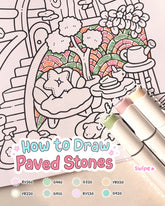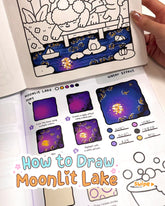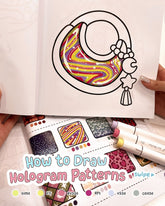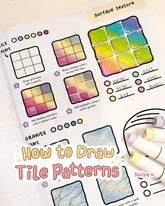Different Types of Marker Tips for Coloring Style
Table of Contents
When you're new to coloring, the variety of marker tips might feel overwhelming at first but don't worry. Once you get to know them, you’ll start to see them not just as tools, but as little creative companions that guide the flow of your expression.
What Are the Different Types of Marker Tips?
Let’s explore in two simple ways: by size and by shape.
Different Marker Tips by Size
Each tip size offers unique advantages, catering to different coloring needs and styles.
Extra Fine Tip
Extra fine tip markers feature the thinnest tips, typically around 0.4mm or smaller. They are ideal for intricate details, fine lines, and precise work.

Best For:
- Detailed patterns and designs
- Outlining small area
- Adding fine accents
Usage Tips:
- Use a light touch to prevent damaging the delicate tip.
- Ideal for slow, deliberate strokes to maintain precision.
- Ensure the marker is stored horizontally to maintain ink flow
Fine Tip
Fine tip markers are characterized by their slender, pointed nibs, typically ranging from 0.4mm to 0.7mm in width. This design allows for controlled, consistent lines, making them ideal for detailed work.

Best for:
- Outlining intricate designs
- Adding fine details to illustrations
- Hand lettering and journaling
- Coloring small, precise areas
Usage tips:
- Apply gentle pressure to maintain the integrity of the fine tip.
- Store markers horizontally to ensure even ink distribution.
- Use smooth, high-quality paper to prevent ink bleeding and feathering
Medium Tip
Medium tip markers typically feature a nib size ranging from 1.8mm to 2.5mm. This size offers a harmonious balance between precision and coverage, making them ideal for various artistic applications.
Best for:
- Filling standard coloring book areas
- Creating bold outlines and lettering
- General-purpose coloring and drawing
- Crafting and DIY projects
How it feels: Using a medium tip marker feels intuitive and comfortable, allowing for smooth, consistent strokes.
Helpful tips:
- Apply even pressure to maintain consistent line width.
- Ideal for beginners due to their forgiving nature.
- Store markers horizontally to ensure even ink distribution.
- Test on scrap paper to familiarize yourself with the marker's flow and coverage.
Broad Tip
Broad tip markers, usually with a chisel-shaped nib, can create both thick and thin lines depending on how you hold them.

Best for:
- Filling large spaces with smooth color
- Creating bold strokes and lettering
- Mixing precision and expressive movement
How it feels: Like using a paintbrush and pen in one: bold and satisfying for big, flowing strokes.
Helpful tips:
- Use the flat side for coverage and the edge for detail.
- Experiment with angles to control line width.
- Store markers horizontally for even ink flow.
Quick Beginner Tips for Choosing Tip Sizes
- Start with medium or fine tips for most coloring books.
- Use extra fine for mandalas or line art.
- Try broad/chisel if you enjoy abstract or free-style coloring.
- Don’t worry about picking “wrong”, you’ll learn by trying.
🎨 Coloring isn’t about perfection, it’s about connection.
Different Marker Tips by Shape
The shape of the tip affects how you move your hand, how the ink flows and how expressive your coloring can be. These differences give you endless ways to explore and connect with your mood.
Bullet Tip
Bullet tip markers feature a rounded, firm nib that delivers consistent, medium-width lines. This design offers a balance between precision and coverage, making them suitable for various coloring tasks.

Best for:
- Filling standard coloring book shapes
- Creating bold outlines
- Lettering and journaling
How it feels:
Using a bullet tip marker feels intuitive and comfortable, allowing for smooth, consistent strokes. It's like having a reliable companion that adapts to your creative needs.
Helpful tips:
- Apply even pressure to maintain consistent line width.
- Ideal for beginners due to their forgiving nature.
- Store markers horizontally to ensure even ink distribution.
- Test on scrap paper to familiarize yourself with the marker's flow and coverage.
Brush Tip
Brush tip markers have a flexible, paintbrush-like nib that changes line width with pressure and angle. They’re perfect for coloring, blending, illustration and calligraphy.

Best for:
- Fluid lines and expressive strokes
- Smooth color blending
- Hand lettering and detailed artwork
How it feels: Like painting with a pen: smooth, responsive, and full of movement.
Helpful tips:
- Adjust pressure to control line thickness, light pressure for thin lines, heavier pressure for broader strokes.
- Practice on scrap paper to get comfortable with the brush's responsiveness.
- Use smooth, high-quality paper to enhance blending and prevent feathering.
- Clean the tip after use to maintain its flexibility and prevent color contamination.
Dual Tip (Combo)
Dual tip markers feature two distinct nibs on opposite ends of the marker, typically combining a fine tip for detailed work and a broader tip such as a brush or chisel for covering larger areas. This design offers flexibility, allowing artists to switch between precision and broad strokes without changing tools.

Best for:
- Detailed illustrations and fine lines
- Coloring large areas with ease
- Calligraphy and hand lettering
- Blending and shading techniques
How it feels:
Using a dual tip marker feels like having two tools in one, providing the convenience to seamlessly transition between intricate details and expansive strokes. This adaptability enhances the creative process, making it more fluid and efficient.
Helpful tips:
- Utilize the fine tip for outlining and adding intricate details.
- Use the broader tip for filling in larger areas and creating dynamic strokes.
- Practice blending techniques by layering colors with the broader tip.
- Store markers horizontally to maintain even ink distribution
Quick Beginner Tips for Choosing Tip Shapes
You don’t need to own every marker tip to start. Just choose one that feels good in your hand and matches how you want to feel while you color. You can always grow your collection later as your style evolves.
How to Choose Types of Marker Pen Tips for Coloring Style
Step 1. Reflect on Your Coloring Approach
- Do you prefer bold and swift strokes or detailed and mindful coloring?
- For expressive, sweeping motions, a brush tip offers flexibility and dynamic lines.
- For precise, controlled work, a fine tip or bullet tip provides accuracy and consistency.
Step 2. Consider the Scale of Your Artwork
- Are you working on large backgrounds or intricate patterns?
- For covering expansive areas, a chisel tip or broad tip is efficient.
- For small, detailed sections, a fine tip is ideal.
Step 3. Evaluate Your Comfort and Control
- Do you feel more comfortable with firm tips or flexible ones?
- Bullet tips offer a balance between firmness and versatility.
- Brush tips require a bit more control but allow for varied line widths.
Step 4. Test Different Tips
- Experiment with various marker tips to see which feels most natural.
- Try a dual-tip marker to experience both fine and broad strokes.
How to Care for Your Marker Tips
Cap them tightly after use:
Always close the cap right after using your markers to stop the ink and tip from drying out.
Store markers flat:
Keep them lying horizontally so the ink stays evenly distributed, especially for dual-tip markers.
Use light pressure:
Press gently while coloring to protect soft brush or dot tips from bending or fraying.
Clean when ink slows down:
If ink flow feels uneven, gently wipe the tip with a damp cloth or a little rubbing alcohol to clear dried ink.
Avoid heat and cold:
Store your markers in a cool, dry place to prevent the ink from thickening or drying too fast.
Check for damage regularly:
Inspect your markers now and then for frayed tips, cracks, or leaks to catch problems early.
FAQs
Which marker tip is best for beginners?
For beginners, bullet tips are often recommended due to their versatility and ease of control. They provide consistent lines suitable for coloring and writing, making them ideal for those new to markers. As skills develop, experimenting with other tips like brush or chisel can expand creative possibilities.
What are differences between brush tip and chisel tip markers?
Brush tips are flexible and mimic the feel of a paintbrush, allowing for varied line widths and expressive strokes. Chisel tips have a firm, angled edge, enabling both broad and fine lines depending on the angle used. The choice between them depends on the desired artistic effect and personal preference.
Can I use different marker tips for the same artwork?
Absolutely! Combining various marker tips can enhance the depth and texture of your artwork. For instance, using fine tips for intricate details and brush tips for broader strokes can create a dynamic and visually appealing piece.
Are dual-tip markers worth it?
Dual-tip markers offer the convenience of two tip types in one marker, such as a fine tip on one end and a brush or chisel tip on the other. This versatility allows for seamless transitions between detailed work and broader strokes without switching tools. They are especially beneficial for artists who value efficiency and versatility.
How do I maintain different marker tips?
Proper care includes capping markers tightly after use to prevent drying, storing them horizontally to ensure even ink distribution, and applying gentle pressure during use to avoid damaging the tips. Regular cleaning of the tips can also help maintain consistent ink flow.
Do marker tip sizes affect the outcome of my artwork?
Yes, tip sizes significantly influence the precision and style of your artwork. Fine tips are ideal for detailed lines and small areas, while broader tips like chisel is better suited for filling larger spaces and creating bold strokes. Selecting the appropriate tip size enhances the overall quality and effect of your work.
Can marker tips be replaced or interchanged?
Some marker brands offer replaceable or interchangeable tips, allowing artists to switch between tip types or replace worn-out tips without purchasing a new marker. This feature adds to the longevity and versatility of the markers. It's advisable to check with the manufacturer regarding tip replacement options.
How do I choose the right marker tip for my project?
Consider the nature of your project: for detailed illustrations, fine or bullet tips are suitable; for expressive artwork or calligraphy, brush tips are ideal; for covering large areas, chisel or broad tips work best. Assessing the specific requirements of your project will guide you in selecting the most appropriate marker tip.
How do fine tip markers differ from extra fine tip markers?
Fine tip markers typically have a tip size around 0.4mm, suitable for detailed work and writing. Extra fine tip markers have an even smaller tip, around 0.2mm, ideal for intricate details and precision work.
What projects are chisel tip markers best suited for?
Chisel tip markers are versatile, allowing for both broad strokes and fine lines depending on the angle used. They are commonly used for highlighting, lettering, and covering large areas.











